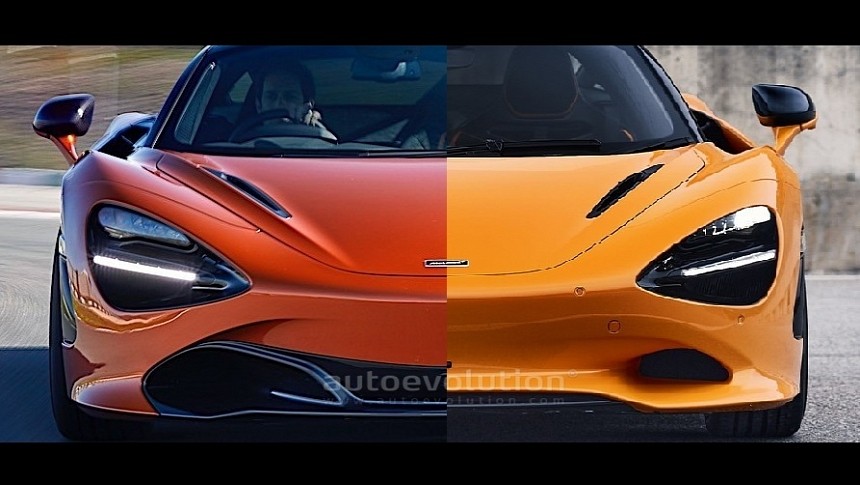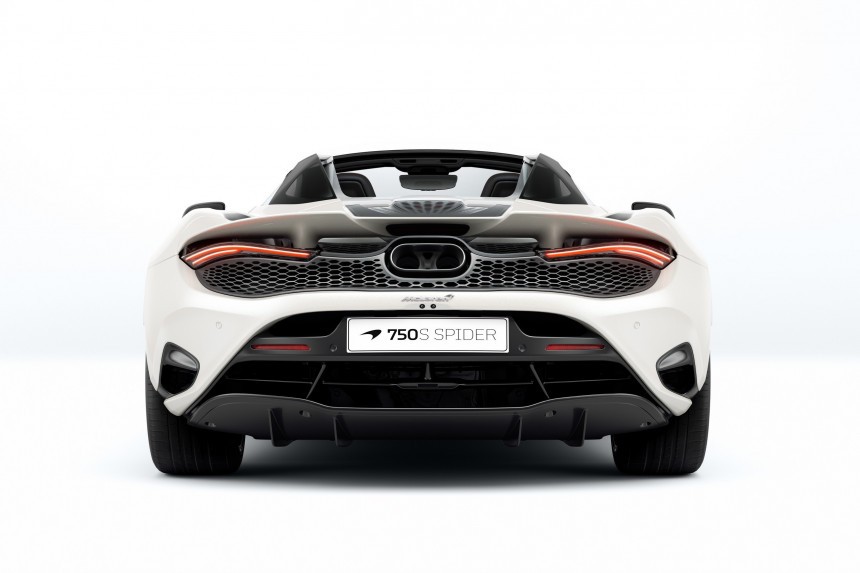The latest supercar to have graced the motoring world came from McLaren earlier this week. It's called the 750S, and it is an evolution of the 720S. Call it a mid-cycle refresh, if you will, a very welcomed addition to the range, for that matter, as the 720S is already six years old, and that makes it less favorable apparently to some enthusiasts.
Upgrades were applied to all key areas, starting with the very restrained looks of the re-tuned chassis, weight-saving measures, and more power squeezed from the V8. In the latter department, you're looking at 30 hp (30 ps/22 kW) and 22 lb-ft (30 Nm) of torque more than what you get in the 720S. The 750S' twin-turbo 4.0-liter V8 is good for 740 hp (750 ps/552 kW) at 7,500 rpm and 590 lb-ft (800 Nm) of torque at 5,500 rpm.
This translates to 0-62 mph (0-100 kph) in 2.8 seconds in both body styles, Coupe and Spider, a one-tenth improvement over the 720S. With 7.2 sec required to hit 124 mph (200 kph), the 750S Coupe is six-tenths faster. The top speed has dropped from 212 to 206 mph (341-332 kph), and the quarter-mile takes 10.1 instead of 10.3 seconds. On paper, the 750S is an improvement as far as the performance is concerned anyway, but chances are most enthusiasts won't be able to tell the difference in real-world driving. The weight was dropped from 2,828 pounds (1,283 kg) to 2,815 pounds (1,277 kg) dry.
Since we're in the technical department, we might as well tell you about the re-tuned chassis, with Macca mentioning the PCC III, which is their latest linked-hydraulic suspension. It features new dampers and springs, which are lighter than before, exclusive accumulator tuning, and tweaked geometry for better feedback when pushing through corners at the racetrack. The updated steering ratio will also help, though again, unless you were born to be a pro racing driver, you probably won't feel like there's any improvement here. The superior Senna served as inspiration when it came to the carbon ceramic brake discs and calipers. The nose-lift system was improved, taking four instead of ten seconds to lift the front end of the car to clear speed bumps.
The new 750S may look the same to you and me as the old car. But several design upgrades are worth mentioning, like the new front bumper with smaller air intakes. McLaren says the side intakes were revised to cool down the V8 better. This supports the small increase in power. The best way to differentiate them is to look at the rear end, as the exhaust tips were mounted in the middle on the 750S and were styled to appear as a single entity. This move wouldn't have been possible without fitting a new rear bumper, sporting a smaller McLaren logo above the license plate. The diffuser has more pronounced fins, the reflectors are smaller, and the taillights are new.
Minor updates were applied inside, like the brand's corporate logo replacing the McLaren lettering on the steering wheel. Along with the upgraded cameras, a new infotainment screen with better graphics is on deck. Future buyers won't have to pay more for Apple CarPlay, as this is standard, and the driver and passenger have USB-C and USB-A sockets at hand too. Another novelty is the MCL (McLaren Control Launcher), which is capable of storing the driver's favorite settings for the aero, transmission, powertrain, and handling. Returning to the desired configuration is made at the push of a button. Elsewhere, you are looking at the same stuff carried over from the 720S, and that's not bad at all, considering that the interior seems to be aging just fine.
McLaren's 720S used to have an MSRP of $310,500 in the United States before it was quietly dropped last year. As expected, the new 750S is a bit pricier, with the British automaker asking a minimum of $324,000 for the Coupe before the $5,500 transportation and port processing charges. If you want the Spider, you will have to cough out at least $345,000 and another $2,240 for the Americas Accessories Pack. By comparison, the Ferrari F8 kicks off at nearly $285,000 but is less powerful, with 710 hp (720 ps/530 kW). The base price for a 2023 Lamborghini Huracan STO exceeds that of the 750S by almost $10,000, and the Raging Bull's mid-engine machine won't stick around for much longer, as it is in the process of being replaced, just like the bigger Aventador that evolved into the electrified Revuelto.
To you and me, if you're fortunate enough to own a 720S, then you don't need to upgrade to the 750S. But if you want to experience the new McLaren anyway, place an order, as chances are you won't be disappointed by it. After all, it builds on an excellent foundation.
This translates to 0-62 mph (0-100 kph) in 2.8 seconds in both body styles, Coupe and Spider, a one-tenth improvement over the 720S. With 7.2 sec required to hit 124 mph (200 kph), the 750S Coupe is six-tenths faster. The top speed has dropped from 212 to 206 mph (341-332 kph), and the quarter-mile takes 10.1 instead of 10.3 seconds. On paper, the 750S is an improvement as far as the performance is concerned anyway, but chances are most enthusiasts won't be able to tell the difference in real-world driving. The weight was dropped from 2,828 pounds (1,283 kg) to 2,815 pounds (1,277 kg) dry.
Since we're in the technical department, we might as well tell you about the re-tuned chassis, with Macca mentioning the PCC III, which is their latest linked-hydraulic suspension. It features new dampers and springs, which are lighter than before, exclusive accumulator tuning, and tweaked geometry for better feedback when pushing through corners at the racetrack. The updated steering ratio will also help, though again, unless you were born to be a pro racing driver, you probably won't feel like there's any improvement here. The superior Senna served as inspiration when it came to the carbon ceramic brake discs and calipers. The nose-lift system was improved, taking four instead of ten seconds to lift the front end of the car to clear speed bumps.
Minor updates were applied inside, like the brand's corporate logo replacing the McLaren lettering on the steering wheel. Along with the upgraded cameras, a new infotainment screen with better graphics is on deck. Future buyers won't have to pay more for Apple CarPlay, as this is standard, and the driver and passenger have USB-C and USB-A sockets at hand too. Another novelty is the MCL (McLaren Control Launcher), which is capable of storing the driver's favorite settings for the aero, transmission, powertrain, and handling. Returning to the desired configuration is made at the push of a button. Elsewhere, you are looking at the same stuff carried over from the 720S, and that's not bad at all, considering that the interior seems to be aging just fine.
McLaren's 720S used to have an MSRP of $310,500 in the United States before it was quietly dropped last year. As expected, the new 750S is a bit pricier, with the British automaker asking a minimum of $324,000 for the Coupe before the $5,500 transportation and port processing charges. If you want the Spider, you will have to cough out at least $345,000 and another $2,240 for the Americas Accessories Pack. By comparison, the Ferrari F8 kicks off at nearly $285,000 but is less powerful, with 710 hp (720 ps/530 kW). The base price for a 2023 Lamborghini Huracan STO exceeds that of the 750S by almost $10,000, and the Raging Bull's mid-engine machine won't stick around for much longer, as it is in the process of being replaced, just like the bigger Aventador that evolved into the electrified Revuelto.
To you and me, if you're fortunate enough to own a 720S, then you don't need to upgrade to the 750S. But if you want to experience the new McLaren anyway, place an order, as chances are you won't be disappointed by it. After all, it builds on an excellent foundation.












